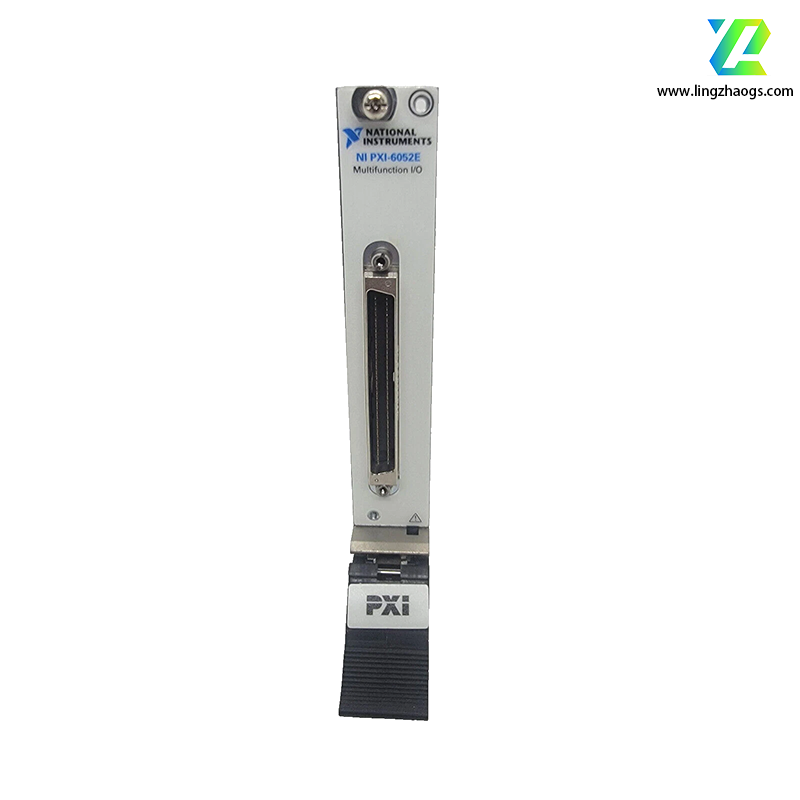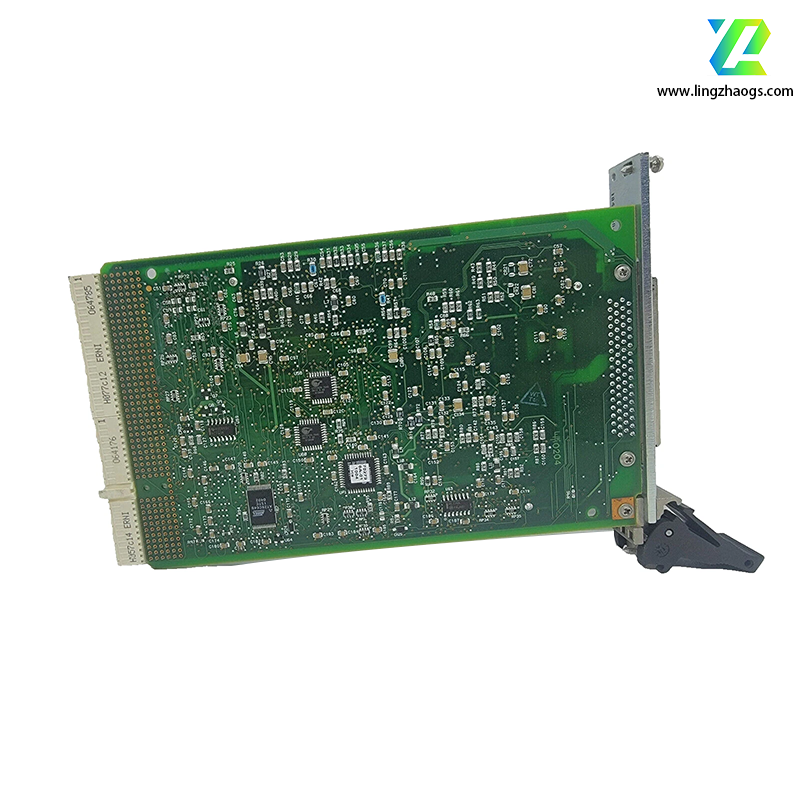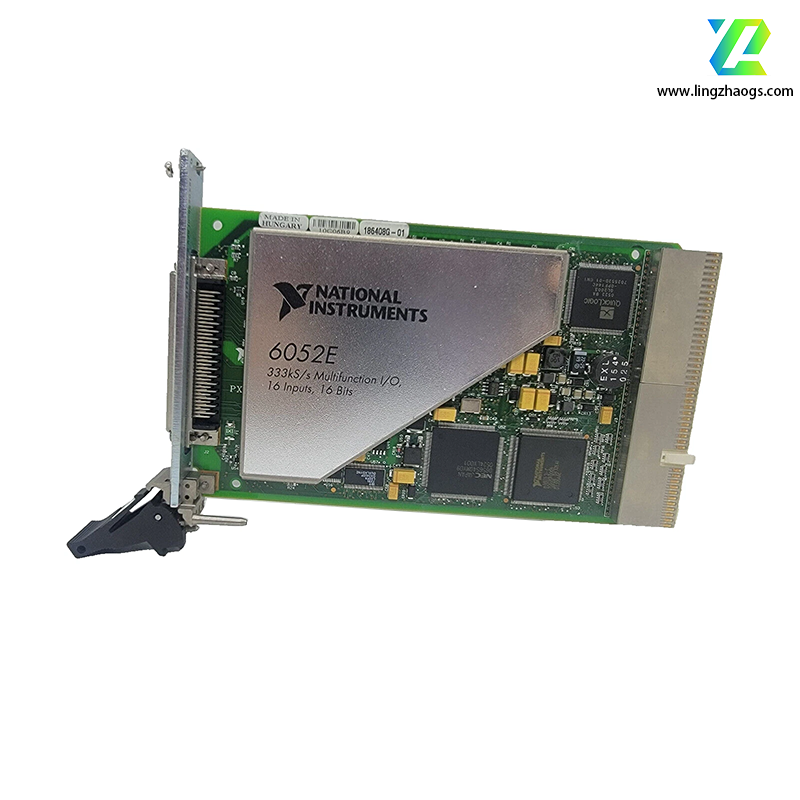Detailed Specifications of NI PXI-6052E Multifunction DAQ Module
The NI PXI-6052E is a mid-speed, high-precision multifunction data acquisition (DAQ) module belonging to National Instruments (NI)’s legacy E-Series, engineered for the PXI bus architecture. Its defining features include 16 single-ended/8 differential analog input channels, 333 kS/s sampling rate, and 16-bit resolution, making it ideal for applications requiring balanced performance between speed and channel density—such as industrial process monitoring, automated test benches, and laboratory data logging. Integrating analog I/O, digital functions, and precision timing, it delivers reliable performance in cost-sensitive modular systems.
1. Basic Information
- Module Series: E-Series multifunction DAQ module, optimized for PXI modular systems
- Part Numbers: 777962-01 (standard model); 186408G-01, 186408H-01 (variant models)
- Physical Dimensions: 1-slot 3U PXI form factor, 10.0 cm × 16.0 cm (width × length) (consistent with E-Series PXI footprint)
- Weight: Approximately 5.6 ounces (0.16 kg) (estimated based on E-Series form factor)
- +5 V DC (1.2 A) (via PXI backplane)
- +12 V DC (0.3 A), -12 V DC (0.1 A) (auxiliary power for signal circuits)
- Interface Type: 68-pin VHDCI (Very High-Density Cable Interconnect) connector; 32-bit, 33 MHz PXI bus interface
- Operating Temperature Range: 0°C ~ 55°C (commercial grade)
- Shock Resistance: 50 g peak (11 ms duration)
- Vibration Resistance: 2 g RMS (10 Hz ~ 500 Hz)
- Relative Humidity: 5% ~ 95% (non-condensing)
- Isolation: Non-isolated (signal paths share common ground reference)
- Compliance: Meets FCC Part 15 Class A, CE EN 61326-1, and UL 61010-1 safety & EMC standards
- Warm-up Time: 15 minutes (required for optimal accuracy)
2. Core Technical Specifications
2.1 Analog Input
- 16 single-ended (SE) / 8 differential (DIFF) channels (software-selectable)
- Supports Referenced Single-Ended (RSE), Non-Referenced Single-Ended (NRSE), and Differential (DIFF) modes
- Resolution: 16-bit ADC (Analog-to-Digital Converter), no missing codes (differential nonlinearity: ±0.5 LSB)
- Maximum single-channel rate: 333 kS/s (kilo samples per second)
- Multi-channel aggregate rate: 333 kS/s (synchronized multiplexing across all channels)
- Input Ranges: 15 software-switchable ranges to accommodate diverse signal amplitudes , including:
- ±0.1 V, ±0.2 V, ±0.5 V, ±1 V, ±2 V
- ±5 V, ±10 V, ±20 V (full-scale ranges)
- Integral Nonlinearity (INL): ±1 LSB (maximum)
- Absolute Accuracy: 4.96 mV (typical at ±10 V range)
- Input Impedance: 10 GΩ (parallel with 100 pF)
- Common-Mode Rejection Ratio (CMRR): 90 dB (DC ~ 60 Hz)
- Overvoltage Protection: ±42 V (powered on), ±25 V (powered off)
- Buffer Memory: 512-sample onboard FIFO buffer, supporting burst-mode acquisition and reducing CPU load
- Signal Conditioning: Compatible with NI SCC (Signal Conditioning Cartridge) and SCXI modules for sensor-specific conditioning (e.g., thermocouple, strain gage)
2.2 Analog Output
- Channel Count: 2 independent analog output channels
- Resolution: 16-bit DAC (Digital-to-Analog Converter), integral nonlinearity: ±1 LSB
- Update Rate: Up to 100 kS/s per channel (supports waveform generation for control signals)
- Output Range: ±10 V (standard), output current: ±5 mA continuous per channel; ±20 mA peak (short-circuit limited)
- Performance: Offset error ±2 mV (typical), gain error ±0.1% of full scale (typical)
2.3 Digital I/O
- Channel Configuration: 8 bidirectional TTL/CMOS-compatible digital I/O lines
- Input: 0 V (low) ~ 5 V (high)
- Output: 0 V (low) ~ 5 V (high), 4 mA source/sink current per line
- Functionality: Software-configurable input/output direction per line; supports general-purpose control, status monitoring, and digital triggering
2.4 Counter/Timer
- Configuration: 2 independent 24-bit up/down counters
- Timebase: 20 MHz internal clock (stability: ±50 ppm typical)
- Event counting (up to 10 MHz input frequency)
- Frequency/period measurement (resolution: 50 ns)
- Pulse width modulation (PWM)
- Pulse generation (custom duty cycle: 0.1% ~ 99.9%)
2.5 Synchronization & Triggering
- Internal: 20 MHz precision oscillator (DAQ-STC timing controller)
- External: 0.1 Hz ~ 10 MHz clock input via front-panel PFI (Programmable Function Input) lines
- Analog Edge Trigger: Rising/falling edge with adjustable threshold (±42 V range)
- Digital Edge Trigger: TTL-compatible edge on digital I/O or PXI trigger lines (0 ~ 7); configurable polarity
- Software Trigger: API-initiated trigger for automated test sequences
- Pre/Post Triggering: Supports pre-trigger data capture (trigger position adjustable in acquisition buffer)
- Data Transfer: 3 independent DMA (Direct Memory Access) channels with scatter-gather mode, enabling high-efficiency data transfer (up to 132 MB/s via PXI bus)
3. Software & Driver Support
- Recommended Drivers: NI-DAQmx 8.0 and above; legacy NI-DAQ (Traditional DAQ) also supported
- Programming Compatibility:
- NI Ecosystem: Fully integrated with LabVIEW (7.0+), LabWindows/CVI (7.0+), and Measurement Studio (7.0+)
- Third-Party Languages: Supports C/C++, C#, Visual Basic, and Python (via pyDAQmx bindings)
- Operating Systems: Compatible with Windows (XP/Vista/7/10) and Linux distributions
- Configuration Tools: NI Measurement & Automation Explorer (MAX) for channel mapping, range selection, and system calibration
- Calibration & Diagnostics:
- Self-calibration support with temperature and timestamp logging
- External calibration recommended every 2 years
- FIFO underflow/overflow detection, signal path integrity self-test, and onboard temperature monitoring
4. Typical Application Scenarios
The NI PXI-6052E’s balanced speed and channel count make it ideal for:
- Industrial Process Monitoring: Multi-point measurement of temperature, pressure, and flow in chemical plants; analog output for valve control
- Automated Test Benches: Stimulus-response testing of consumer electronics (e.g., audio amplifiers, sensor modules); digital I/O for DUT (Device Under Test) power control
- Laboratory Data Logging: Environmental chamber monitoring (temperature, humidity, vibration) with synchronized sampling
- Automotive Electronics: ECU (Electronic Control Unit) validation via simultaneous acquisition of engine sensors (speed, torque, fuel pressure)
- Mechanical Control: Position/speed feedback measurement for motor control systems; analog output for actuator drive signals
5. Selection & Compatibility Notes
- Ideal Use Cases: Applications requiring 8+ analog input channels, 333 kS/s sampling rate, and PXI modular integration; suitable for mid-speed, cost-sensitive multi-signal acquisition
- Comparison with E-Series Models:
- vs. NI PXI-6031E: PXI-6052E offers higher sampling rate (333 kS/s vs. 100 kS/s) but fewer channels (16 SE vs. 64 SE); choose for speed over channel density
- vs. NI PXI-6071E: PXI-6052E has lower resolution (16-bit vs. 12-bit) but higher sampling rate; ideal for general-purpose vs. high-accuracy tasks
- Chassis Compatibility: Works with all NI 3U PXI chassis (e.g., PXI-1042, PXI-1050) and third-party PXI-compliant chassis
- Signal Conditioning: Pair with SCXI-1125 (amplification) or SCXI-1144 (isolation) modules for harsh environment use
- Cable Accessories: Compatible with NI SHC68-68-EPM shielded cables for noise reduction in industrial settings
- Limitations: Non-isolated design (avoid use in high-voltage environments >42 V); small FIFO buffer (512 samples) may require frequent CPU intervention for long acquisitions
- Higher Sampling Rate: NI PXI-6070E (1 MS/s, 16-bit, 16 SE channels)
- More Channels: NI PXI-6031E (64 SE channels, 100 kS/s)
- PCI Form Factor: NI PCI-6052E (identical functionality for desktop test systems)





